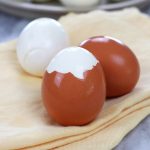
Easy Peel Hard Boiled Eggs
This Easy to Peel Hard Boiled Eggs recipe simplifies life when making deviled eggs, egg salad or Easter eggs for coloring, even when using fresh eggs. Additionally, this method is easiest on the eggs, does not crack the shells and is the approach chef’s and restaurants use.
Servings 12 servings
Calories 72kcal
Equipment
Ingredients
- 12 large eggs *See Note #1 below
- 2 cups water *for steaming, additional water will be needed for ice bath
- 5 cups Ice
Instructions
Steaming Eggs
- Place a steaming basket into a stockpot that has a lid or a large frying pan with a lid.
- Add approximately 1 inch of water to the bottom of the pan.
- Bring to a boil over high heat with lid attached.
- Once boiling, add eggs and replace lid. Steam for 6-7 minutes for soft boiled eggs and 12-13 minutes for hard boiled eggs.
- Meanwhile, add ice and approximately 4-5 cups of cool water to a large bowl.
- Once eggs are done steaming immediately transfer to ice bath and let sit for 15 minutes before peeling.
Peeling Eggs {option #1}
- Countertop PeelingTap egg on the countertop gently to crack the shell.
- Roll egg gently between your hand and the countertop. This will help to loosen the shell making for easier peeling.
- Start peeling the egg of its shell. See Note #2 below.
- Run egg under cold water to remove any excess pieces of shell.
Peeling Eggs {option #2}
- Container PeelingPlace eggs into a container with a tight fitting lid.
- Add enough cold water that the eggs are halfway submerged in the water.
- Secure lid onto container.
- Shake the container vigorously in an up and down motion for approximately 40 seconds to 1 minute.
- The shells should be cracked making for easy peeling.
- Rinse eggs in cold water to remove any excess shell pieces.
Notes
Recipe Notes
Note #1- As little as 1-2 eggs can be prepared using this method.
For the best results it is best to use eggs that are straight from the refrigerator. The shock of cold to hot and back to cold denatures the egg white proteins causing them to pull away from the stubborn membrane.
Note #2- Often the large end is the easiest to start peeling because of the air pocket on that end. However, sometimes the smaller end is easiest to begin with.
Nutrition
Calories: 72kcal | Carbohydrates: 0.4g | Protein: 6g | Fat: 5g | Saturated Fat: 2g | Polyunsaturated Fat: 1g | Monounsaturated Fat: 2g | Trans Fat: 0.02g | Cholesterol: 186mg | Sodium: 78mg | Potassium: 69mg | Sugar: 0.2g | Vitamin A: 270IU | Calcium: 32mg | Iron: 1mg